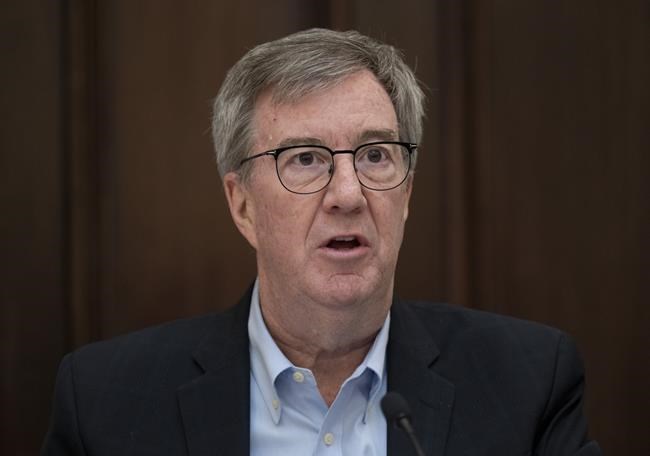OTTAWA — Top city officials painted a scene of frustration and confusion Monday over demands for police resources to deal with the "Freedom Convoy" in downtown Ottawa, ending with an accusation that a federal minister had engaged in "friendly fire."
Serge Arpin, outgoing chief of staff to Ottawa Mayor Jim Watson, testified to disagreements and mix-ups between different levels of government on how they sought to deal with the protesters who descended on the city for three weeks in February.
He told the Public Order Emergency Commission that the number of officers the RCMP said were available never matched the number of officers actually available for deployment to the Ottawa Police Service, which had asked for hundreds more to join its policing effort.
The city's frustrations were the subject of a series of text messages between Arpin and Mike Jones, the chief of staff to Public Safety Minister Marco Mendicino, which were shared with the commission.
They texted back and forth in the days leading up to the federal government's invocation of the Emergencies Act, which is the subject of the inquiry.
In response to a text from Jones about the number of RCMP officers available, Arpin said the RCMP "are lying to you flat out."
The commission heard that confusion resulted from the RCMP sending members to protect specific federal buildings in the parliamentary precinct, such as the Prime Minister's Office.
"(The officers) are not accessible to us. They are protecting federal assets," Arpin wrote to Jones.
In another message, he took issue with how Emergency Preparedness Minister Bill Blair had told media that "the lack of enforcement was somewhat inexplicable" and that "we need police to do their jobs."
"It is friendly fire from you guys," Arpin wrote. "Don't kid yourself."
Jones tried to defend Blair's comments, saying he believed the minister was directing his concerns to the police response, not city hall's.
"If I were to generalize I think on our side the frustrations are felt with (Ottawa police), not the city," he wrote.
The commission also saw evidence Monday that top city officials were warned before convoy demonstrators arrived in the city that their intention was to dig in their heels.
That included an email from the "Canada United Truckers Convoy," forwarded to top city officials and Watson on Jan. 25, that said protesters were trying to book hotels for "a minimum of 30 days."
Police also had information from a local hotel association suggesting protesters were planning to stay for an extended period, and wrote in a Jan. 26 report shared with the city that "all open source information and our interactions with organizers indicate that this will be a significant and extremely fluid event that could go on for a prolonged period."
The federal Liberal government declared an emergency under the Emergencies Act on Feb. 14, granting police extraordinary temporary powers in an attempt to clear the protests that had gridlocked downtown streets for nearly three weeks.
The commission, which heard from city manager Steve Kanellakos on Monday, is expected to hear testimony from Watson and other top Ottawa officials this week.
Kanellakos said the city shared information with Ottawa police and based its planning and response on the intelligence and threat assessment it received from police.
"The only information we could rely on was from Ottawa police, in terms of reliable information at that time," said Kanellakos. "Ottawa police has extensive experience dealing with demonstrations in the national capital."
By Jan. 31, it became clear to Kanellakos and the city that the protests would continue beyond the weekend. In a text message to a city councillor that day, Kanellakos said the strategy was "a negotiation to balance (the protesters') need to get downtown and get them to park in controlled areas."
As the protests continued, there were concerns that demonstrators were becoming entrenched, and the police didn't have the resources to deal with them.
Kanellakos said officials knew that a plan put together by city officials and convoy organizers to move "Freedom Convoy" protesters' semi trucks out of residential neighbourhoods and onto the street in front of Parliament Hill was not going to end the protest.
The deal would not have cleared all residential streets, or the area along Rideau Street, of protesters. And documents filed with the commission show that the Parliamentary Protective Service raised concerns with the prospective plan out of fear that the area around Parliament Hill would become a "parking lot."
Documents filed with the commission state that the intelligence Kanellakos received from police said there was "a potential for violence and weapons" in certain areas of the protests along Rideau Street, where there were people known to police. Those areas were considered to be more "dangerous and volatile."
Documents said "disagreement or misunderstanding" about how many RCMP officers were actually available to support the policing effort was the subject of several meetings.
The Ontario government was invited to the meetings, but did not participate.
Ontario Premier Doug Ford, who is not on the list of witnesses appearing before the inquiry, was asked by reporters about his participation during an announcement in Ottawa on Monday.
Ford said he stood shoulder-to-shoulder with Prime Minister Justin Trudeau during the convoy.
"If you disrupt the lives of the people of Ottawa every single day, disrupt the lives and economic flow across our borders, I have zero tolerance for it," he said.
Ford also said police did an incredible job ending the protests.
"They were very peaceful, they moved forward, and I am so proud to stand here and back our police right across this country and right across this province," Ford said.
This report by The Canadian Press was first published Oct. 17, 2022.
David Fraser, The Canadian Press



